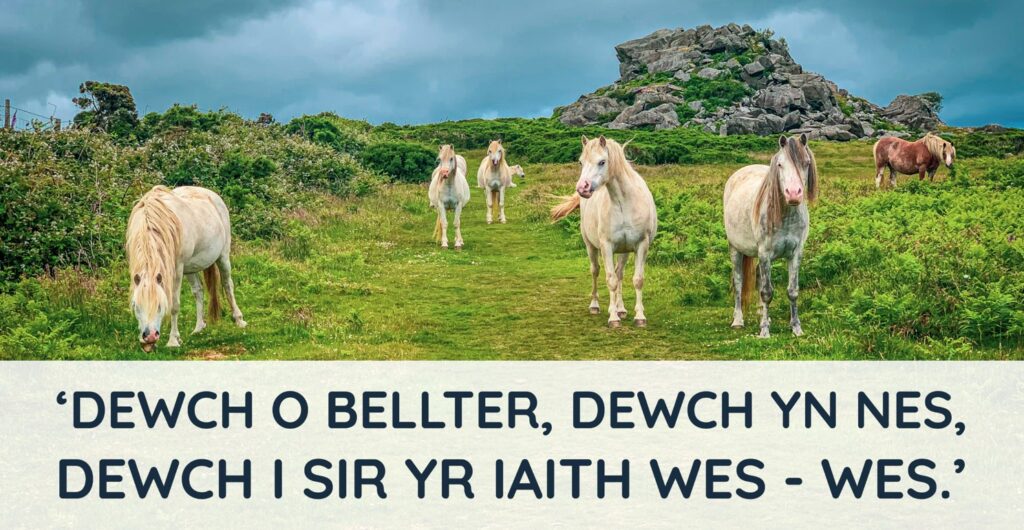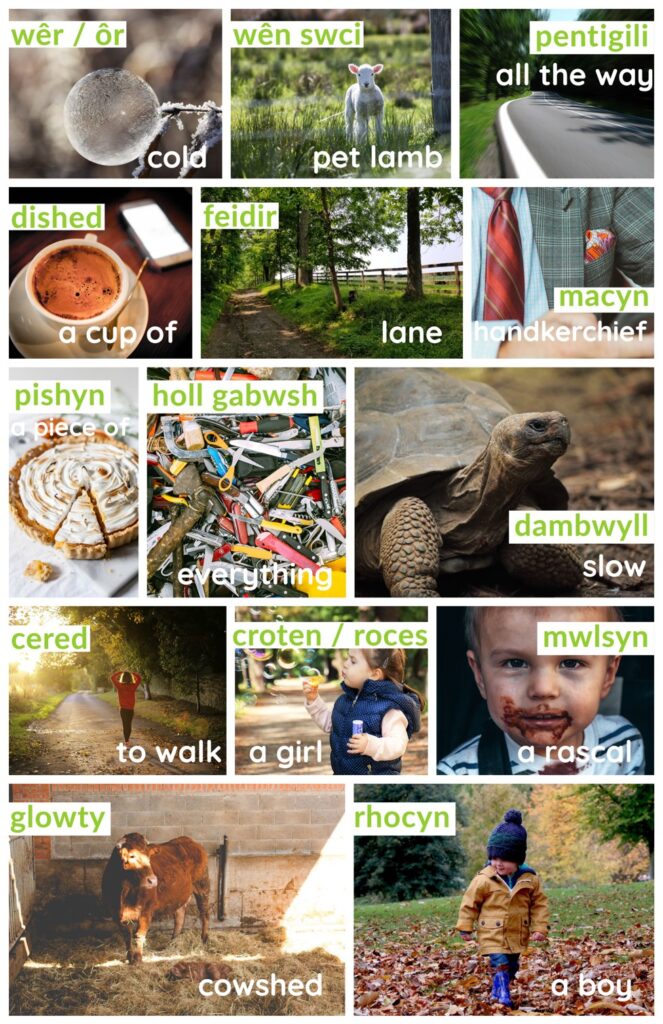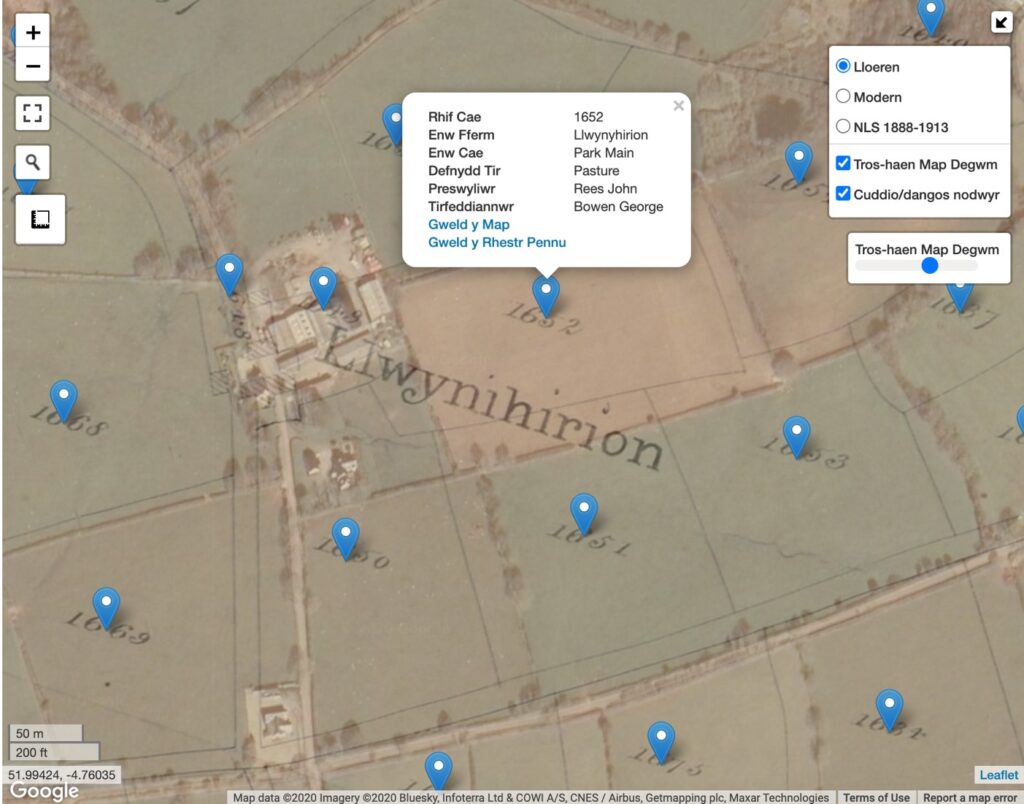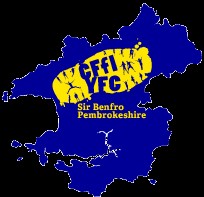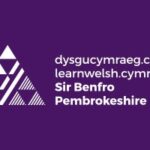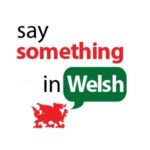Welsh in the Llwynihirion Area
by Janet Philips
In the words of the Pembrokeshire children’s writing squad and the chaired bard Mererid Hopwood, ‘Come from a distance, come closer, come to the county of the ‘Wes – wes’ language.
The Welsh language is one of the treasures of Wales and is one of the oldest and most robust living minority languages in Europe. Brynberian and its surrounding area is one of the traditional strongholds of the Welsh language. In this bilingual area, Welsh is central to our heritage and is the basis of daily life in many homes. It is also a vital part of local culture, organisations, clubs and societies as well as our rich history.
The community surrounding the village of Brynberian and the community centre at Llwynihirion, like other agricultural areas in the Preseli hills, was predominantly a Welsh speaking area. The farms were mostly owned by Welsh speaking farmers. These farms have been passed down through the generations and are still farmed to this day by the same Welsh speaking families.
In 1931, over 81% of the population of North Pembrokeshire spoke Welsh and until the mid twentieth century, Brynberian was a thriving community with many hubs, where the locals were able to socialize and have daily gatherings. There were numerous grocery shops (Siop y Banc, Brynberian; Siop Rafel, Siop Crosswell to name a few), pubs, chapels, a petrol station, a working mill and post offices. Regrettably most of these have closed.
During the 1960s and 1970s, many members of the community became involved in the campaigning for Welsh people to be able to use the Welsh language in every aspect of their lives. This resulted in changes such as bilingual signposts, with priority given to the Welsh language, Radio Cymru – the Welsh language radio channel which was first transmitted on 3rd January 1977 – and S4C – the Welsh language television channel first transmitting on the 1st of November, 1982.
During the later part of the last century, newcomers have moved to the area. Fortunately most of these have been sympathetic towards the Welsh language – quite a few having learnt Welsh and the language is still thriving. In the 2011 census, the Eglwyswrw Community Council area comprised 62.3% Welsh speakers.
Welsh encompasses you in Brynberian, from the Welsh speaking families still farming the farms passed down through the generations to the young Welsh children who are educated through the medium of Welsh in the local schools.
Dialect
North Pembrokeshire has its own dialect with each area having its own unique vocabulary. This unique dialect certainly shows what area of Wales a person originated from. In the past Welsh speakers tended to stay in their area for most of their lives resulting in a strong dialect.
“We’ve got our own character, we’ve got our own own way of speaking using dialect, and it’s fascinating for people who come to Pembrokeshire for the first time.” Hedydd Hughes.
This is the land of “Wes, wes.” Here are a few examples of our unique dialect words:
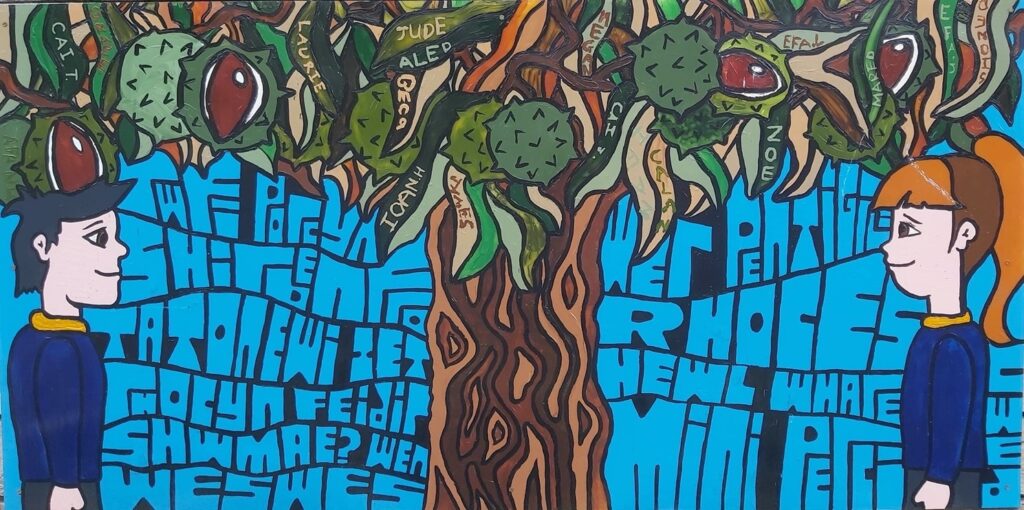
to showcase local dialect words
To discover more about Pembrokeshire’s dialect, take a look at the links and books below:
Tafodiaith Sir Benfro Facebook Group:
https://www.facebook.com/groups/386937631359386
Pembrokeshire Dialect Facebook Group:
https://www.facebook.com/PembrokeshireDialect
‘Rhint y Gelaets a’r Grug’ by Wyn Owens ( a dictionary of Pembrokeshire dialect words)
A glossary of the Demetian Dialect of North Pembrokeshire’ by W.Meredith Morris.
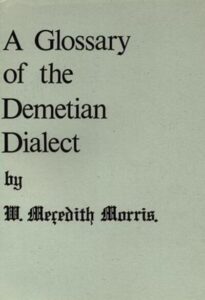
Welsh Place Names
In 1985, it was legislated that road signs in Wales would become bilingual. This ensured that for the first time in some places, both the English and Welsh names for towns and villages would appear on signage. This was an important milestone in Wales. A bilingual sign tells you more than just where you need to go. It tells you a country has more than one native language. It can tell you how the names for these places are connected, or sometimes not, between languages. It teaches you what others call that place in their language.
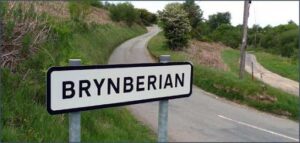
Brynberian itself and some of the surrounding villages only have a Welsh name. Early inhabitants of Wales gave names first to noteworthy natural features, such as rivers, hills, mountains, harbours and shores. Brynberian itself translates to ‘The hill of the river Berian’.
Here are a few other examples for you:
Sir Benfro
pen – end bro – land
‘end of land’
Sir meaning county
‘The county of the end of the land’.
Eglwyswrw
Eglwys – church Wrw – a saint – Saint Wrw
‘St.Wrw’s church’
Maenclochog
maen – rock, stone clochog – as of a bell (ringing)
There were two large stones not far from the church which possessed a ringing property.
‘Ringing stones’
Crymych
Crymych was originally a collection site for cattle herded along the drover’s routes. In the early 1800s there was only a handful of houses, farms and the Crymych Arms.
crwm – crooked ych – ox
‘Crooked ox’
Trefdraeth
Trefdraeth was a busy port founded primarily on the growing medieval wool trade.
tref – homestead or town traeth – beach
‘Beach town’
Clunderwen
clun – meadow derwen – Oak tree
‘Meadow of the oak tree’
Arberth
Narberth was on the fringe of Narberth Forest.
ar – on, near perth – hedge
‘near a hedge’
Pentregalar
It is said that all the men from this village went off to battle. Unfortunately all were killed leaving their families to mourn their losses.
pentref – village galar – grief, sorrow
‘The village of sorrow’
Llandissilio
Llan – church
St.Tysilio was a Welsh prince born in c 640 who became an abbott.
‘Church of St. Tysilio’
Take a look at the website below to see if you can work out the meaning of other local place names:
https://www.wales.com/about/language/place-names-wales
Welsh field names
The Welsh language can also help us learn a lot about the area from the local field names. They are so much more attractive and memorable than Welsh Government identifying numbers. The local field names usually describe the position of the fields or some allude to a special quality of the field for example a field close to the centre is called ‘Park Main’ which translates to ‘Thin Field’.
Search for local field names:
https://lleoedd.llyfrgell.cymru/
Welsh in education
As the mother tongue of most locals, Welsh was naturally used as the medium of instruction in the local primary schools. However, in the 19th century, the Welsh Not was introduced into some schools to stigmatise and punish children using the Welsh language during the school day. This was the result of an enquiry into the state of education in Welsh schools led by three English commissioners. Their report (The Blue Books) caused uproar in Wales for disparaging the Welsh and being particularly scathing in its view of the Welsh language. It stated ‘ The Welsh language is a vast drawback to Wales and a manifold barrier to the moral progress and commercial prosperity of the people.’ After the introduction of the Welsh Not, a pupil caught speaking Welsh would be made to wear a small wooden board etched with WN, until another culprit was caught. At the end of the day, the pupil wearing the Welsh Not would be punished, usually with a cane. This resulted in many viewing the Welsh language as being a disadvantage to them as English was encouraged to be the preferable medium.
After the introduction of the Welsh Not, a pupil caught speaking Welsh would be made to wear a small wooden board etched with WN, until another culprit was caught. At the end of the day, the pupil wearing the Welsh Not would be punished, usually with a cane. This resulted in many viewing the Welsh language as being a disadvantage to them as English was encouraged to be the preferable medium.
After 1888, Welsh again became the norm in primary schools in Welsh medium schools. Every child in Wales now has the right to a Welsh medium education and since 1990 Welsh is now a compulsory subject in all schools in Wales.
Most of the nursery provision in the area is provided through the Mudiad Ysgolion Methrin who provide Welsh medium early years education. The children then transition to the local primary schools where they are taught through the medium of Welsh. They are fully immersed in the Welsh language and begin to have English lessons from the age of 7. By the time they leave their primary education, pupils are bilingual.
Most secondary aged children attend Ysgol y Preseli in Crymych which was established in 1958 as a bilingual comprehensive school. On 1st of September, 1991 it was declared an official bilingual school. It took in pupils from as far as Tenby and Haverfordwest. Today there is another Welsh medium bilingual school in Haverfordwest.
Welsh in Education: https://gov.wales/welsh-in-education
Ysgol y Preseli: http://www.ysgolypreseli.com/
Socialising in Welsh
Since Welsh became compulsory in our schools, the youth of the area are mostly bilingual and can take advantage of a range of opportunities to socialise in Welsh outside of the classroom.
The Urdd
The Urdd (Welsh language of Youth) has been prominent in the community for many years, enabling children and young people to take part in various activities all over Wales. It’s a strong tradition in the local schools that children take part in a variety of Urdd activities such as sports, eisteddfod competitions and residential stays. Young people are also able to take advantage of the Adran (primary age community group) and the Aelwyd (up to 25 years of age community group).
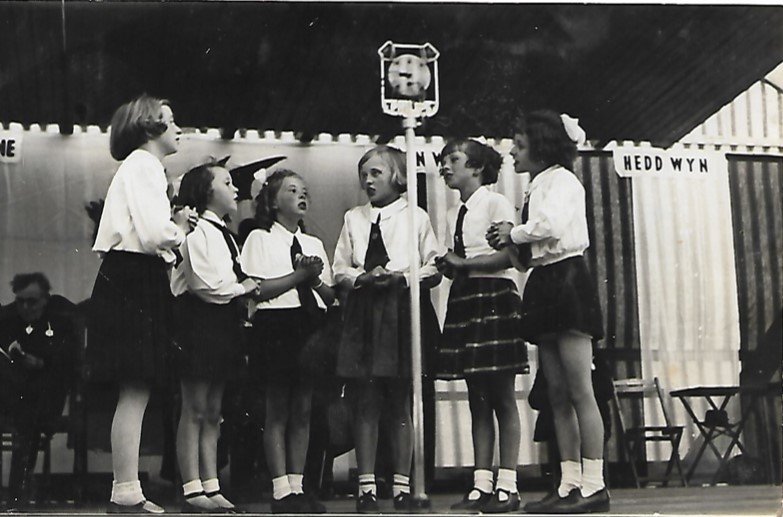
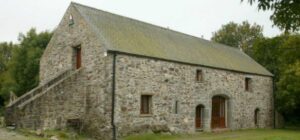
The Urdd organisation also owns Pentre Ifan Farm. Last year it was announced that this centre was to be developed as the first environmental centre for the Urdd (urdd.cymru) to enable a new generation of children and youth to get to know their environmental and cultural heritage.
Young Farmers Club (YFC)
http://pembrokeshireyfc.org.uk/
The Young Farmers’ Clubs in this area are extremely popular with older children and young adults. The YFC promote their work bilingually and give opportunities for the youth to develop skills in their communities in both languages.
Menter Iaith Sir Benfro
http://www.mentersirbenfro.com/
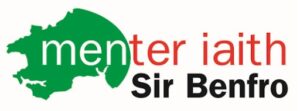 Another organisation that arranges Welsh medium activities for all ages is the ‘Menter Iaith’. Menter Iaith Sir Benfro is an organisation working to raise the profile of the Welsh language within the county through various activities.
Another organisation that arranges Welsh medium activities for all ages is the ‘Menter Iaith’. Menter Iaith Sir Benfro is an organisation working to raise the profile of the Welsh language within the county through various activities.
Merched y Wawr
http://merchedywawr.cymru/rhanbarth/penfro/
This is another popular organisation in this area. Merched y Wawr is an organisation established in 1967 for women in Wales whose activities are conducted through the medium of Welsh to promote culture, education and the arts. The local branch meets regularly every month at Crosswell.
Clebran Newspaper
Some locals are part of the editorial team for a local Welsh paper called ‘Clebran’ which translates as ‘chatting’. The paper was founded in 1974 and can be bought in local independent shops.
The centre at Llwynihirion also host numerous activities where you’ll find the locals conversing in Welsh. These activities and organizations, such as the Urdd, Young Farmers’ Clubs, Merched y Wawr, and a host of other local societies discussed above, have a key role in supporting the Welsh language in our community. They are responsible for developing local leaders and supporting volunteers, as well as providing essential social activities through the medium of Welsh.
The local Eisteddfod at Brynberian
Numerous activities are held through the medium of Welsh in the community throughout the year – concerts, dramas (usually held in the village hall at Crosswell) and penny readings (singing and reciting competitions for money prize.)
The first Eisteddfod was held in the old Llwynihirion school back in 1987. From 1987-1993 it was called a Competitive Meeting. By 1994 the title had been changed to the Brynberian Eisteddfod. From the beginning a variety of competitions were offered including music, recitation, literature and drawing.
The first Competitive Meeting was chaired by Mr Aneurin Lewis, Carmarthen (Rhuanfa). The judges were Mrs Mair Garnon James, Mrs Eirlys Davies and Mrs Merryl Roberts.
By 2001 the title had changed to the Chaired Brynberian Eisteddfod. However, a small chair had been a prize in the literary department since 1993 and the first winner was Mrs Mair Garnon James. The late Godfrey Dobbins, who ran the village shop, was the craftsman of the small chairs for years; it was always a pleasure to see his new design. In recent years Tecwyn James has been the Chair’s designer and we always thank him for his fine work.
Undoubtedly, the most enthusiastic person to create and hold an annual Eisteddfod was the late Jennie Howells, Glynyrwyn. As Secretary since 1990, I spent many hours organizing the annual programme with Jennie giving the orders. She was one of the leaders from the beginning and the mistress of the Chairing ritual. Her unique talent and humour created a fun and homely atmosphere. When Jennie asked someone to be president, they couldn’t refuse!
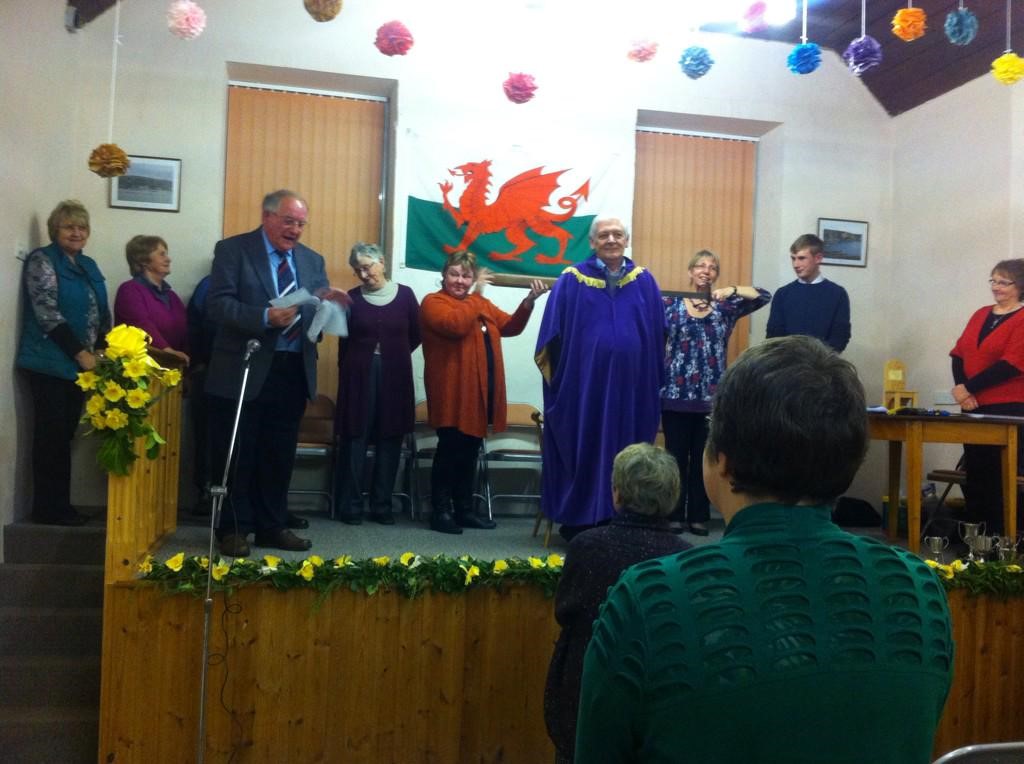
Since 2003 the Eisteddfod has been a member of Small Eisteddfodau Cymru. This means a lot more publicity for small Eisteddfodau in the country via the internet.
See the website: steddfota.org
All the best for the future.’ Ceri Davies, Eisteddfa.
Learning Welsh in the area
If you’re a newcomer to the area, there are numerous opportunities for you to learn the language. Many newcomers have taken advantage of local or online courses. Some have met in each other’s houses to hold Welsh classes and have integrated with the Welsh speakers of the area to practice their newly learnt language and sometimes to learn Welsh songs and poems. One of those from Brynberian who is now a fluent Welsh speaker is Jennie Welton, who was awarded Pembrokeshire’s Welsh Learner of the Year in 2019.

Read her story here:
https://www.pembrokeshire.gov.uk/newsroom/pembrokeshire-welsh-learner-of-the-year-2019
Cymraeg 2050: A Million Welsh Speakers
The Welsh government’s ambition is to see the number of people able to enjoy speaking and using Welsh reach a million by 2050.
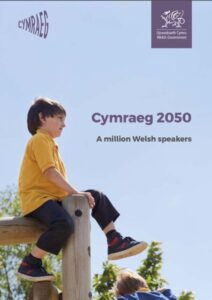
https://gov.wales/sites/default/files/publications/2018-12/cymraeg-2050-welsh-language-strategy.pdf
You too can be part of that million. There are numerous opportunities to learn Welsh. Here are a few examples of local or online courses that can suits your needs:
Learn Welsh Pembrokeshire (To join a locally held class)
https://learnwelsh.cymru/about-us/providers/learn-welsh-pembrokeshire/
Watch the video below to discover what level of courses are available locally:
https://www.youtube.com/watch?v=duY97Xd2tG0
Say Something in Welsh (To join an online course) https://www.saysomethingin.com/welsh
Janet Phillips – Biography
Janet has lived in the Brynberian area since the age of two. Having had her early education at Llwynihirion School she has very fond childhood memories of the locality and after her studies returned to make Brynberian her home once again. Her working years involved teaching at various Pemrokeshire primary schools. Along with her husband Meredith, they have two daughters who spent their childhood years growing up in the area. The family has a strong bond with the locality and spend their leisure time walking along the mountains and in the woods. Janet is a trustee of the Llwynihirion Community Centre and was pleased to see the renovation of her old school so that it can continue to be a local hub.

